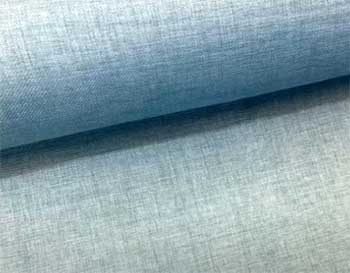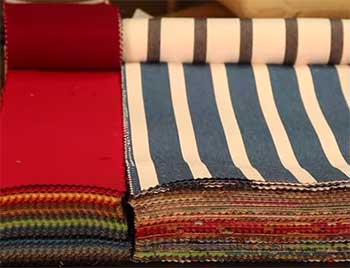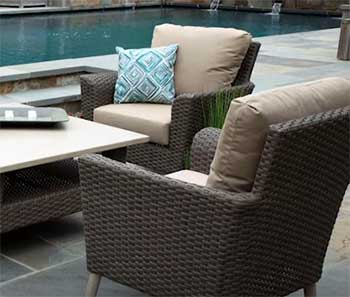Outdoor fabrics like Solarium and Sunbrella have become increasingly popular options for patio furniture, boat covers, and outdoor shade structures. But with so many fabric choices on the market, how do you know which one is right for your needs?
Here we’ll compare Solarium and Sunbrella head-to-head so you can decide which outdoor fabric is best for your next project.
A Brief Comparison Table
| Feature | Solarium | Sunbrella |
| Fabric Type | Polyester | Acrylic |
| Water Resistance | Moderate, 1500mm rating | Excellent, 3000+mm rating |
| UV Resistance | Good, 1500 hours | Excellent, 3000+ hours |
| Fade Resistance | Moderate fading over 1-2 years | Excellent, retains vibrant color for 5+ years |
| Breathability | Moderate | Excellent |
| Durability | Moderate, 2-3 years lifespan | Excellent, 5-7+ years lifespan |
| Cleaning | Moderate, stains may be hard to remove | Excellent, resists staining and cleans easily |
| Cost | $12-25 per yard | $18-30+ per yard |
| Style/Color Options | Decent range of solids and patterns | Huge selection of solids, prints, and colors |
Overview of Solarium and Sunbrella

Solarium is a brand name for a type of polyester fabric made by Mermet USA that is designed for outdoor use.
It is made from high-density polyester yarns that are coated with a PVDF finish that helps provide water resistance, UV protection, mold/mildew resistance, and stain resistance.
Solarium has a similar look and feel to acrylic fabrics.
Sunbrella is a brand name for a type of acrylic fabric made by Glen Raven that is also designed for outdoor use.
It is made from 100% solution-dyed acrylic yarns and given a special finish to help make it water repellant, breathable, fade resistant, and easy to clean. Sunbrella is known for being a very durable and fade resistant outdoor fabric.
Key Differences Between Solarium And Sunbrella Fabrics
Both fabrics are designed to handle outdoor conditions and resist fading, but they have slightly different properties that may make one better suited for certain applications. Here we’ll look at the key factors to compare.
- Water and Stain Resistance
One of the main jobs of an outdoor fabric is resisting moisture. Both Solarium and Sunbrella perform well in this category, but Sunbrella generally has better ratings for water repellency and stain resistance.
Solarium’s PVDF coating does make it water-resistant and stain-resistant to some degree. However, most Solarium fabrics have a hydrostatic pressure rating of around 1500 mm, meaning they can only withstand a water column of pressure up to 1500mm before leaking through.
This makes Solarium moderately water resistant, but not waterproof. The fabric will shed light rain, but may soak through in heavy downpours.
Sunbrella has a proprietary fluorocarbon coating that provides excellent water repellency, with most styles rated over 3000 mm hydrostatic pressure resistance. This coating allows Sunbrella to repel rain, dew, and moisture much better than Solarium. Sunbrella is also more effective at resisting stains from spills and dirt.
If you need an outdoor fabric that will really resist wet weather and high traffic, Sunbrella is the better choice. The superior water and stain resistance can help furniture upholstery and shade covers last longer without becoming dingy or soaked through.
- UV Resistance and Fade Protection
Outdoor fabrics need excellent UV resistance and fade protection to maintain their color and integrity through years of sun exposure. Both Solarium and Sunbrella rate well in this area, but Sunbrella once again has a slight edge.

Solarium offers good UV resistance with an estimated 1500 hours of fade resistance.
The polyester fabric will gradually fade and degrade over time in the sun.
However, Solarium tends to retain color better than lower-grade polyester fabrics designed for indoors.
Sunbrella leads the pack when it comes to fade resistance, with ratings over 3000 hours for most styles.
The solution-dyed acrylic yarns are highly stable and retain vibrant color much longer than other fabric types. Sunbrella only loses about 1-2% of its color per year, even with constant sun exposure.
If retaining the original vibrant colors of your outdoor cushions, umbrellas, or awnings is a priority, Sunbrella is your best bet. The exceptional fade resistance keeps outdoor projects looking fresh and new season after season.
- Fabric Breathability and Comfort
One benefit of outdoor fabrics over vinyls is that most offer some level of breathability, allowing air to pass through the fabric weave. This breathability makes them more comfortable in hot weather than solid vinyl.
Solarium has moderate breathability that makes it reasonably cool and comfortable to sit on. Air can pass through the polyester yarns to allow moisture and heat to escape. However, Solarium is still warmer to sit on compared to more open fabrics like mesh.
Sunbrella offers very good breathability for an outdoor fabric. The loose acrylic weave allows lots of airflow, helping to reduce heat buildup underneath. Cushions and furniture covers made with Sunbrella feel cooler and more comfortable on hot sunny days compared to Solarium or vinyls.
For outdoor furniture covers, boat covers, and cushions that will be used in warm climates, Sunbrella’s superior breathability gives it the comfort advantage over Solarium.
- Strength and Durability
Durability is essential for an outdoor fabric that will face weathering, sunlight, and regular use. Solarium and Sunbrella both offer good durability, but Sunbrella is generally regarded as the stronger and more long-lasting material.
Solarium has decent strength and abrasion resistance. The dense polyester holds up better than basic polyester fabric but not as well as higher performing outdoor textiles. With proper care, Solarium can last several years outdoors but will eventually degrade from UV and weather exposure.
Sunbrella is highly durable and rated to last approximately 5-7 years or longer with proper maintenance. The tightly woven acrylic fibers resist tearing or fraying, even under intense UV exposure.
Sunbrella is abrasion-resistant and structurally reinforced to prevent ripping and damage. Heavy-duty construction makes it very durable under active outdoor use.
For furniture covers, shade sails, and other applications needing long-term outdoor performance, Sunbrella is by far the better choice. Solarium can work for short-term temporary use but won’t match Sunbrella’s longevity and durability in the elements.
- Ease of Cleaning and Care
To keep outdoor fabrics looking their best, you need to be able to clean and maintain them easily. Both Solarium and Sunbrella are designed for simple care, but Sunbrella’s stain resistance gives it an advantage here as well.

Solarium can be spot cleaned using mild soap and water, but stains may be difficult to remove once set.
Bleach and other harsh detergents can damage Solarium over time.
To clean Solarium, you’ll need to be diligent about treating stains and spills quickly before they set.
Sunbrella’s inherent stain resistance makes it much easier to care for.
Stains have a harder time setting into the fabric and can usually be cleaned just by hosing down the fabric.
For deeper cleaning, you can use a bleach solution, commercial outdoor fabric cleaner, or even a pressure washer on Sunbrella without risk of damage.
Due to the easy cleaning and staining properties, Sunbrella requires less work to keep it looking fresh. Solarium needs more babying to keep it clean long-term.
- Cost Comparison
When looking at cost, Solarium is typically the more budget-friendly option compared to Sunbrella. However, Sunbrella’s superior durability and longevity help offset the higher initial price over time.
Solarium ranges from $12-25 per yard, making it one of the most affordable outdoor-rated fabrics. This can be appealing if you need to cover a large space on a budget. However, the lower cost also reflects the shorter lifespan you can expect from Solarium, often 2 years or less.
Sunbrella starts at $18-30 per yard and goes up from there based on style. While the upfront investment is higher, Sunbrella is designed to last 5-7 years outdoors, so you get more value from the fabric over time. Considering the exceptional longevity and resistance to fading or tearing, Sunbrella offers excellent durability per dollar spent.
If you’re looking to decorate your patio or build new covers on a tight budget, Solarium is the more wallet-friendly choice. But for permanent shade structures, boat covers, or furniture you want to last for years, Sunbrella provides better long-term value despite the higher initial price tag.
- Style, Color, and Pattern Options
Both Solarium and Sunbrella are available in a wide range of colors and patterns to suit any outdoor décor. However, Sunbrella offers substantially more diversity with hundreds of fabrics to choose from.
Solarium is limited to solid colors and a handful of striped or geometric patterns from Mermet. The color palette options tend to be more muted and limited compared to other outdoor fabrics. Still, the selection is varied enough for basic outdoor furniture projects.
Sunbrella opens up seemingly endless possibilities for matching your style. There are over 200 vivid solid colors that never fade as well as endless stripes, florals, geometrics, and novelty prints. Sunbrella offers on-trend patterns and enough diversity to coordinate with any color palette or theme.
For one-off DIY projects needing a color match, Solarium should have something that will work. But for interior designers or commercial applications wanting a signature look, Sunbrella’s vast library provides the ultimate selection.
Which Is Better For Shade Sails Or Umbrellas?
For shade sails, umbrellas, and other devices designed to block UV rays, Sunbrella is the top choice of fabric. The exceptional fade resistance helps the fabric maintain UV protection as it ages.
And the durable construction stands up to flapping and wind forces over time.
Solarium makes decent DIY shade sails or umbrella covers if you plan to replace them every 2 years or so. But for permanent professional shade structures expected to last 5+ years through intense sun and wind, Sunbrella is far superior.
The added cost brings much greater longevity and reliability.
Which is Better for Patio Furniture Covers and Cushions?
For covering patio furniture like tables, chairs, cushions, and ottomans, Sunbrella is also the preferred fabric. The tighter weave helps block more dust and debris compared to more open-weave fabrics like Solarium.
And Sunbrella’s unbeatable fade protection keeps cushions looking vibrant year after year.
Solarium cushion covers may save you money upfront. But the colors will fade within 1-2 seasons, and you’ll end up having to replace cushion covers more frequently.
Opting for Sunbrella covers means your patio furniture stays looking fresh and new for years before needing to be replaced.
Which Is Better For Boat Covers And Biminis?
In the hot, wet, salty marine environment, Sunbrella reigns supreme for boat covers, biminis, and any canvas boat tops or enclosures. The durable acrylic material resists mildew and holds up to years of sun, wind, and water exposure better than polyester.
Boat covers need to handle moisture and UV exposure, making Sunbrella the top choice. Solarium boat covers can work for temporary, short-term use. But for long-term protection, investing in Sunbrella marine-grade fabric will save your boat from damage and save you money over time.
Frequently Asked Questions (FAQ)
Solarium is one of the closest comparisons, offering decent water resistance, UV protection, and durability at a lower cost. Other fabrics like Outdura, Phifertex, and Saratoga rate similarly for outdoor performance at a budget price, but none match Sunbrella’s longevity and resistance to fading.
Solarium is a good mid-range outdoor fabric for the price. It resists fading, water, and UV damage better than basic polyester but not as well as premium acrylics. Solarium works great for temporary outdoor furniture covers and shade structures on a budget. But for permanent, long-lasting pieces, higher-end options like Sunbrella offer better durability.
Solarium has decent water resistance but is not completely waterproof like vinyls. It will shed light rain but can become saturated with heavy rainfall over time. For good waterproofing, you may need to apply a water repellent finish periodically as the factory coating wears off.
For certain key factors like fade resistance, breathability, and durability, Sunbrella is considerably better than Solarium. You’ll get 5+ years of vibrant, long-lasting color from Sunbrella versus 1-2 years before fading becomes noticeable with Solarium. And Sunbrella’s tight acrylic weave makes it more tear-resistant while still feeling cool and comfortable to sit on. For projects needing to withstand intense sun and use, paying a little more for Sunbrella can be worthwhile.
The Bottom Line
For most outdoor applications, Sunbrella is hands-down the superior fabric compared to Solarium. You can expect over twice the lifespan from Sunbrella, with better water resistance, breathability, and fade protection that adds up to a good value despite the higher price.
Solarium works decently for temporary outdoor projects on a budget, but Sunbrella is a worthwhile investment for permanent outdoor furniture, boat covers, shade sails, and more.
If you want outdoor fabric that can withstand years of sun, wind, and rain without compromise, choose Sunbrella for proven long-lasting performance.

